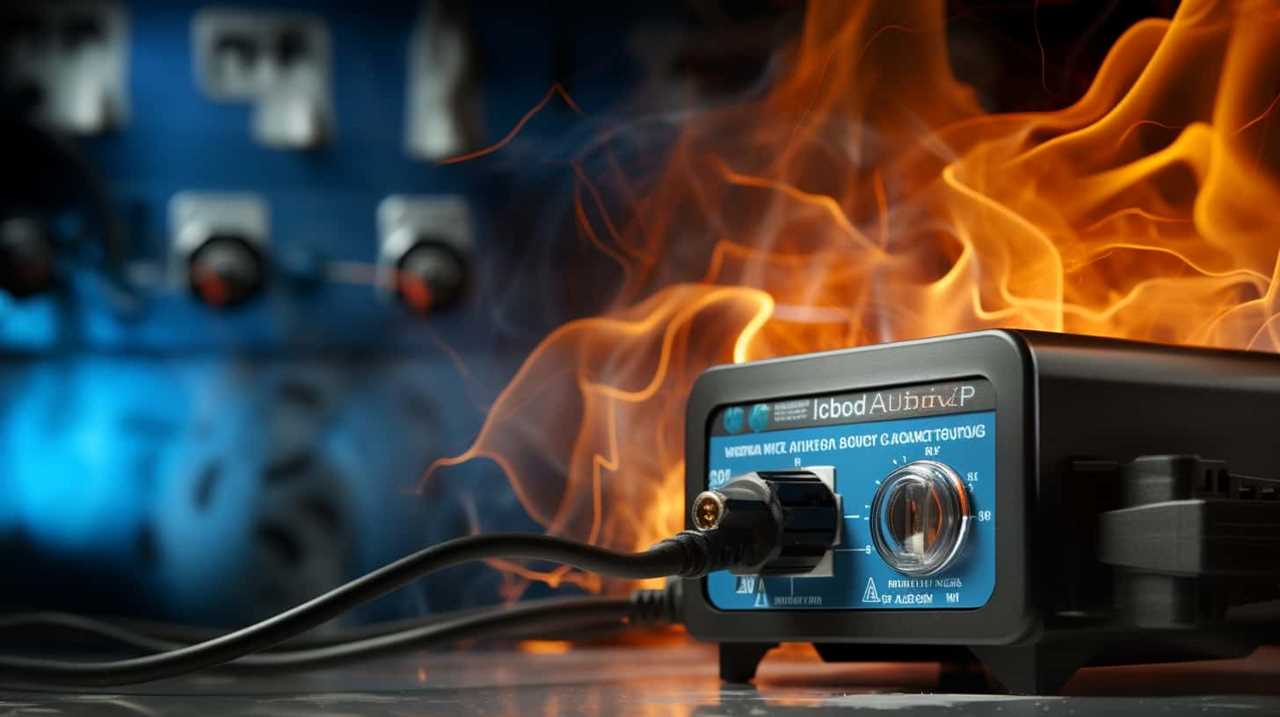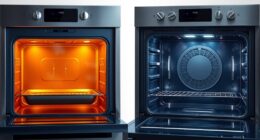Resetting your Samsung fridge is easy and can fix common issues. Start by unplugging the fridge or turning off the power at the circuit breaker for about five minutes. For Family Hub models, use the red switch to perform a screen reset. If you're facing minor glitches, press and hold the "Power" button for 5-10 seconds for a soft reset. For a hard reset, unplug the fridge, wait 5-10 minutes, then plug it back in. After resetting, check the settings to verify everything's at ideal levels. There's a lot more to know, so keep going to master your fridge reset skills!
Key Takeaways
- Unplug the fridge or turn off the circuit breaker for five minutes to reset the appliance effectively.
- For Family Hub models, flip the red switch for 15 seconds to reset the screen.
- Perform a factory data reset via Settings > About Family Hub > Factory data reset for complete restoration.
- Conduct a soft reset by holding the "Power" button for 5-10 seconds to resolve minor glitches.
- Regularly check and replace water filters to maintain optimal performance and prevent issues requiring resets.
Resetting Your Samsung Refrigerator

If your Samsung refrigerator is acting up, resetting it might just do the trick. To reset your Samsung, start by unplugging the fridge or turning off the power at the circuit breaker for at least five minutes. This helps dissipate any residual electrical charge that could be causing issues.
For those with a Family Hub model, you have an additional option: perform a screen reset by flipping the red switch inside the right door for 15 seconds before turning it back on.
If you need a full factory reset for your Family Hub model, navigate to Settings, then About Family Hub, and select Factory data reset. This will erase all user data and restore factory settings, so use it wisely.
Keep in mind that resetting your refrigerator deletes the error code history, which can complicate future diagnostics. It's best to reset only when you encounter specific issues, like the 88 88 error code.
To maintain peak performance and reduce the need for frequent resets, regularly check your temperature settings and replace water filters.
Common Reasons to Reset

You might need to reset your Samsung fridge for a few common reasons.
If you encounter error codes, like 88 88, or if you've recently moved or cleaned the appliance, a reset can help restore proper function.
Regular maintenance also calls for resets to guarantee everything's running smoothly.
Error Code Resolution
Error codes on Samsung refrigerators often signal specific issues that may require a reset to restore normal operation. Understanding these codes is vital for effective troubleshooting. Here are three common reasons you might need to reset your refrigerator:
- Boot Failure (Error Code 88 88): This error indicates a boot failure, often resolved by performing a hard reset. Simply unplugging the fridge for a few minutes can clear the error and get it back to normal.
- Demo Mode (Error Codes O FF or OFF OFF): If you see these codes, your refrigerator is in Demo mode, which doesn't require a reset. Just turn off the Demo mode to get back to regular operation.
- Ice Maker Issues: Persistent problems with your ice maker may require resetting. While defrosting can help, resetting your Samsung refrigerator could restore functionality if issues continue.
Regularly monitoring and addressing error codes can prevent serious problems, making timely resets essential for maintaining peak performance.
If you encounter any of these error codes, don't hesitate to reset your refrigerator for a smoother experience.
Appliance Relocation Adjustments
After relocating your Samsung fridge, it's vital to perform a reset to guarantee it functions properly in its new setting. During transport, your refrigerator can accumulate error codes that could hinder its performance. To avoid potential boot failures, like the 88 88 error code, always reset your fridge after moving it.
Before plugging it back in, let the fridge sit upright for at least 24 hours to allow the refrigerant to settle. This step is important for peak performance.
Once you're ready, perform a reset on your refrigerator to clear any accumulated errors and recalibrate the internal sensors.
Moreover, if you've adjusted the temperature settings or changed the fridge's location, performing a reset can help restore proper cooling functionality. Regularly resetting your fridge during these appliance relocation adjustments not only helps in clearing error codes but also in maintaining its efficiency and longevity.
A simple reset can reboot and recalibrate the control panel, ensuring your fridge operates at its best after being moved. So, don't skip this vital step to keep your Samsung fridge running smoothly!
Routine Cleaning Maintenance
Regular maintenance plays a key role in keeping your Samsung fridge running smoothly, especially when it comes to preventing the need for frequent resets.
By incorporating routine cleaning and maintenance into your schedule, you can enhance performance and avoid issues that could necessitate a reset.
Here are three essential tasks to include in your routine maintenance:
- Clean the Interior: Regularly wipe down the inside of your fridge to prevent odors and bacteria buildup. This not only keeps your food fresh but also helps maintain sensor functionality.
- Dust the Condenser Coils: Dust and debris on the coils can hinder cooling efficiency. Make it a habit to clean these coils to guarantee peak performance and prevent overheating.
- Check and Replace Filters: Regularly inspect your water filters and replace them as needed. This guarantees a clean water supply and reduces issues that might trigger a reset.
How to Perform a Soft Reset
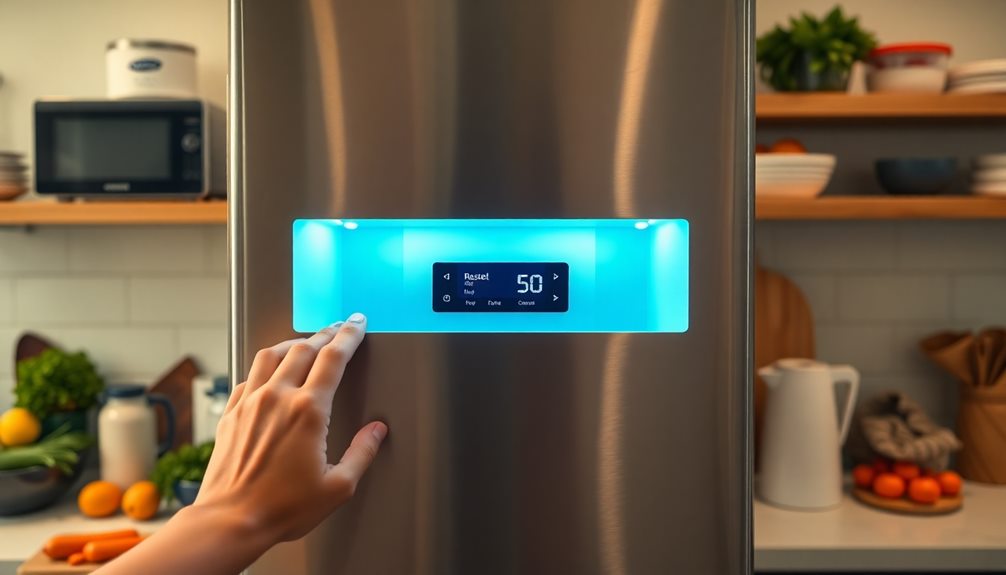
Sometimes, a quick soft reset can resolve minor glitches in your Samsung fridge without disrupting your settings or stored data. If you're looking to reset my Samsung fridge, this is a simple process that can help restore functionality.
Start by verifying that your refrigerator is plugged in and powered on.
To perform the soft reset, press and hold the "Power" button for 5-10 seconds. You'll notice the display turning off and then back on, indicating that the reset is complete. This method effectively addresses issues with the control panel, helping to eliminate any temporary operational hiccups you're facing.
After the soft reset, it's a good idea to check your temperature settings. Make sure they remain set to the ideal levels: 37°F (3°C) for the refrigerator and 0°F (-18°C) for the freezer.
This verifies your food stays fresh and safe. By following these steps, you can easily troubleshoot and maintain your Samsung fridge's performance without the hassle of losing data or settings.
Performing a Hard Reset
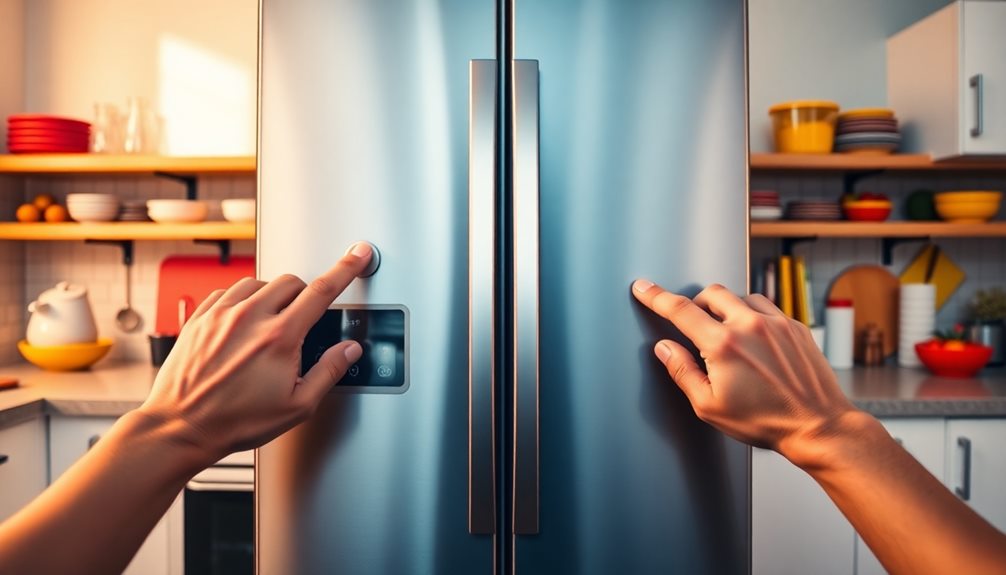
Occasionally, a hard reset can be necessary to troubleshoot more persistent issues with your Samsung fridge. If you're facing ongoing problems, follow these steps to perform a hard reset effectively:
1. Unplug the Fridge: Locate the power cord and unplug the appliance from the power source. This action cuts off power to the internal electronics, allowing them to reset.
2. Wait 5-10 Minutes: During this waiting period, the internal electronics will reset, helping to clear any temporary glitches that may be affecting the fridge's performance.
Patience is key here; don't rush it.
3. Plug It Back In: After the wait, plug the refrigerator back into the power source. Now, check if it's functioning properly.
Keep in mind that while a hard reset often resolves issues, it may not fix everything. So, monitor your fridge's performance closely afterward.
If problems persist, you might need further troubleshooting or professional assistance. Performing this hard reset can often breathe new life into your appliance and enhance its overall efficiency.
Network Reset for Wi-Fi Models

If your Samsung fridge is equipped with Wi-Fi capabilities, you might need to perform a network reset to troubleshoot connectivity issues, especially after a hard reset. To reset your Family Hub refrigerator's network, hold the LOCK button for approximately 12 seconds. When the letters "A" and "r" appear on the screen, you'll know the network reset is in progress.
After the network reset, navigate to Settings > Wi-Fi. Here, you'll want to disconnect from the current network and select your desired Wi-Fi address. Choosing "Disconnect" or "Forget" will erase all Wi-Fi network information stored in your fridge, which means you'll need to reconfigure it for future connections.
This step is essential to guarantee your Family Hub features and smart functionalities work smoothly.
A successful network reset may resolve lingering connectivity issues, giving you seamless access to all your fridge's smart capabilities. However, if problems persist after the network reset, it might be time to consult Samsung support for further assistance. They can provide additional troubleshooting steps tailored to your specific situation.
Troubleshooting After Reset
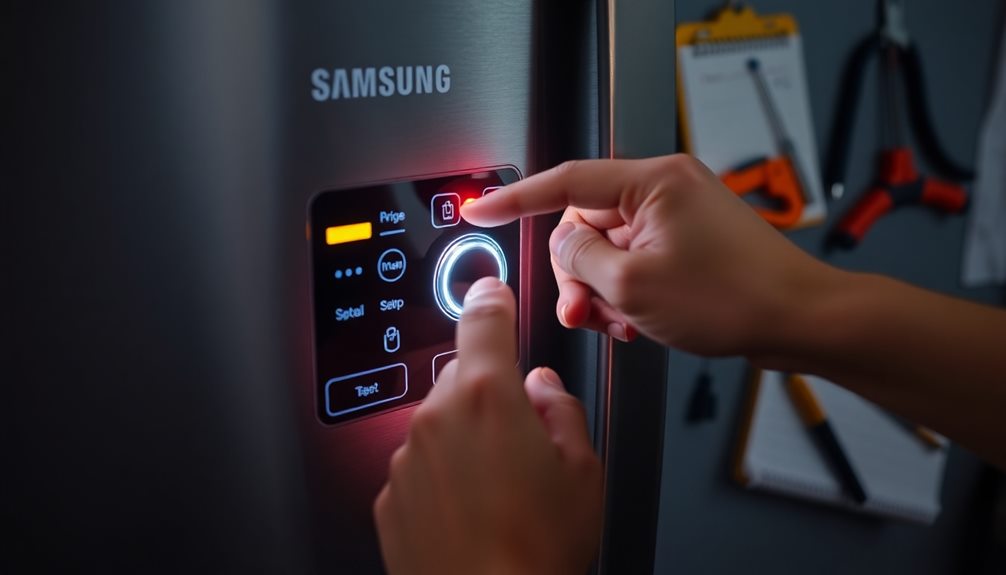
After resetting your Samsung refrigerator, it's crucial to monitor its cooling performance closely. You want to verify that the fridge maintains an ideal temperature of 37°F (3°C) and the freezer at 0°F (-18°C). Checking for lingering issues can help you avoid bigger problems down the line.
Here are three key areas to examine:
- Error Codes: Look at the display panel for any error codes. These codes can indicate unresolved issues that need further troubleshooting.
- Operational Irregularities: Pay attention to any unusual noises or operational irregularities. These could signal mechanical problems that require your attention.
- Airflow: Inspect the vents inside the refrigerator. Make sure they're clear of obstructions to promote proper airflow and prevent ice buildup, which can affect cooling efficiency.
If you notice persistent problems after the reset, it's a good idea to think about scheduling professional service. A trained technician can help diagnose and resolve any technical issues that a simple reset couldn't fix.
Staying proactive can save you time and money in the long run!
Professional Support Options

When you need extra help with your Samsung fridge, reaching out to Samsung Support is a great option.
You can contact them via chat, email, or phone, depending on what works best for you.
If you prefer hands-on assistance, finding a local technician or Samsung Service Center can provide specialized support for more complex issues.
Contacting Samsung Support
While troubleshooting your Samsung fridge, reaching out to Samsung Support can provide the expert assistance you need.
With various ways to connect, you can easily find help tailored to your situation. Here are three options you can choose from:
- Phone Support: Call 1-800-SAMSUNG for direct assistance from a qualified Appliance Technician. They're available from 8 AM to 12 AM EST for home appliance inquiries.
- Online Chat: If you prefer immediate support, use the Samsung Members App or visit the Samsung support website for real-time chat assistance. This is perfect for quick questions or basic troubleshooting.
- Support Guides: Access a wealth of detailed guides on the Samsung website. These include information on error codes, common refrigerator issues, and advice on how to resolve them independently.
Samsung's support guarantees you receive reliable help when you need it.
If you require more extensive assistance, don't hesitate to request service or locate the nearest Samsung Service Center. They'll help you with any appliance-related issues, including confirming your network connection is stable.
Don't wait—contact us today!
Finding Local Technicians
Finding a reliable technician for your Samsung fridge can make all the difference when you need repairs or maintenance. Start by visiting the Samsung support website, where you can use the "Find a Service Center" tool. Just enter your zip code, and you'll see nearby options for local technicians who specialize in refrigerator repairs.
Many Samsung service centers also offer online booking systems, so you can schedule appointments based on your availability. Before you choose a technician, be sure to check customer reviews and ratings to gauge their reliability and service quality. This can give you insight into their repair history and customer satisfaction.
If you're not sure where to begin, don't hesitate to reach out to Samsung's customer support at 1-800-SAMSUNG. They can provide recommendations for certified technicians in your area.
Additionally, some appliance repair services have mobile apps that allow you to request technician visits, track service requests, and even access your repair history directly from your smartphone. This can make managing your refrigerator repairs even more convenient.
Maintenance Tips for Longevity

Maintaining your Samsung fridge is essential for its longevity and peak performance. By following these maintenance tips, you can guarantee that your appliance runs smoothly and efficiently for years to come.
- Check and replace water filters: Regularly replace your water filters every six months. This prevents clogging issues and guarantees you have clean water and maximum ice production.
- Monitor temperature settings: Keep your refrigerator at 37°F (3°C) and your freezer at 0°F (-18°C). Proper temperature settings maximize food preservation and maintain energy efficiency.
- Schedule professional maintenance: Don't forget to book a professional maintenance check at least once a year. This helps identify potential issues early, guaranteeing your fridge stays in top shape.
Additionally, keep the seals on both the exterior and interior clean to prevent cold air from escaping, which can lead to increased energy consumption.
Regularly wipe down surfaces and guarantee there's adequate airflow around vents to avoid overheating.
Summary of Resetting Steps

Knowing how to reset your Samsung fridge can be helpful, especially if you've noticed performance issues despite your best maintenance efforts.
To start, unplug the fridge or turn off the power at the circuit breaker for about five minutes. This allows the electrical charge to dissipate, helping your appliance reset effectively.
If you own a Family Hub model, you can quickly reset the screen using the red switch located inside the right door. Just make sure the fridge is powered off for 15 seconds before switching it back on.
For a more thorough option, perform a factory data reset by maneuvering to Settings > About Family Hub > Factory data reset. Confirm this action to erase all user data and restore factory settings.
Additionally, don't forget to regularly check and replace your water filters, as neglecting this can lead to performance problems that may necessitate a reset.
If you find persistent issues even after a reset, it's best to contact Samsung support for professional assistance rather than relying solely on resets.
Following these steps will help keep your fridge running smoothly.
Frequently Asked Questions
How to Do a Hard Reset on a Samsung Refrigerator?
To do a hard reset on your Samsung refrigerator, unplug it for 5-10 minutes. Afterward, plug it back in to restore power. This can help resolve temporary issues and improve performance.
How Do I Do a Hard Reset on My Refrigerator?
Think of your refrigerator like a phone that occasionally needs a reboot. To reset it, unplug it for five minutes, then plug it back in, and check for any lingering issues. It's that simple!
How Long Should I Unplug My Samsung Refrigerator to Reset It?
To reset your Samsung refrigerator, unplug it for at least 5 minutes. For a more thorough reset, wait up to 10 minutes before plugging it back in to guarantee internal electronics reset properly.
How Do I Restart My Samsung Smart Fridge?
To restart your Samsung Smart Fridge, unplug it for about five minutes or switch off the circuit breaker. For Family Hub models, use the red switch inside the right door for a quick reset.
Conclusion
To summarize, resetting your Samsung fridge can breathe new life into its performance, making it feel like new again. Whether you're tackling a soft reset or a full hard reset, these steps are simple and effective. Remember, a little maintenance goes a long way—after all, wouldn't you rather enjoy a perfectly chilled drink than deal with a malfunctioning appliance? So, go ahead and take charge; your fridge will thank you for it!





